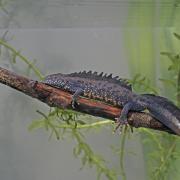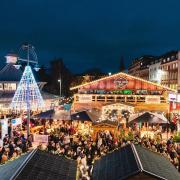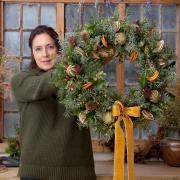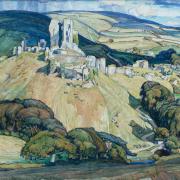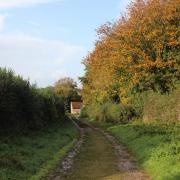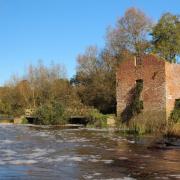Wild places to visit and exciting wildlife adventures to enjoy with Dorset Wildlife Trust
The Restoration of the Great Crested Newt
Great crested newts (above) are a European protected species. This means they are protected by law, as are their eggs, breeding sites and resting places. Unfortunately, like many UK species, great crested newts have experienced a considerable decline in population; a direct consequence of the degradation and destruction of freshwater pond habitats.
Dorset Wildlife Trust’s new Species Recovery Programme aims to enhance the condition of existing ponds throughout our nature reserves, as well as create new hubs of aquatic life. It has already been full steam ahead with the pond restoration work. A team of dedicated volunteers have braved all weather conditions to remove scrub from the south-facing edges of ponds, allowing them to benefit from the sun. Intentional log piles have been left to create hibernacula, a wooden refuge for the newts to use during frosty winter climes. While terrestrial vegetation on the northern side provides safe foraging shelter away from predation.
Thanks to project funding from Natural England, dredging and the removal of silt will help to re-establish the open bodies of water. In addition, eight ponds are being created in areas that lack this aquatic habitat thus creating networks of quality breeding ponds for great crested newts. Bracketts Coppice, Kingcombe Meadows and West Bexington nature reserves will all benefit from this habitat restoration and creation. This work will not only be key to this species’ recovery throughout the Dorset landscape but also support its future resilience against the impact of climate change.
Find more details about this project at dorsetwildlifetrust.org.uk

Water Wisely
June can be hot, so having easily accessible water for wildlife is important (pictured). Topping up bird baths and putting out water for hedgehogs can have a big impact. You can also help protect wildlife in our rivers, streams and reservoirs by being mindful of how we water our gardens. Watering in the early morning or late evening means more water goes to the roots rather than evaporating in the heat of the day.
Find more wildlife gardening tips at dorsetwildlifetrust.org.uk

Powerful Pollinators
Look out for common red soldier beetles (pictured) in your garden this month which are powerful pollinators. This medium-sized, narrow beetle is commonly found on open-structured flowers such as daisies, cow parsley and hogweed. It can also be spotted on grasslands, along hedgerows, and in woodland, parks and gardens. Adults feed on aphids as well as pollen and nectar. And their larvae, which live at the base of long grasses, prey on ground-dwelling invertebrates, such as slugs and snails.

Wildflower of the Month: Cornflower
Once considered a weed of arable fields, intensive agriculture nearly wiped out the cornflower (pictured) in the wild. This delicate, blue flower is now most likely to occur as a garden escapee, as part of intentional wildflower seeding, or as the result of the disturbance of soil containing old seed banks. Its strongholds remain roadside verges, scrub, waste ground and farmland. It flowers from June to August, often alongside other 'cornfield flowers' such as corn chamomile and corncockle.






